Introduction
In an age where data drives decision-making and operational efficiency, the significance of Data Center Integration Services cannot be overstated. These services are essential for organizations aiming to optimize their IT infrastructure amidst the complexities of modern technology. By streamlining operations through the unification of hardware, software, and cloud capabilities, businesses can enhance performance, reduce costs, and improve scalability.
As the demand for sophisticated data management solutions continues to rise—highlighted by the projected $133.7 billion spending on cloud IT infrastructure by 2026—enterprises must navigate the challenges and opportunities presented by data center integration.
This article delves into the critical aspects of data center integration, exploring its benefits, potential challenges, and the pivotal role of automation in shaping a resilient and efficient IT landscape.
Defining Data Center Integration Services
Data center integration services play a crucial role in enhancing the efficiency of facilities by offering a complete range of solutions designed to streamline operations. These services, known as data center integration services, include:
- The consolidation of management systems
- The integration of cloud capabilities
- The unification of diverse hardware and software components, facilitating seamless communication and information flow.
Recent advancements, such as the 22% year-over-year growth in the Asia-Pacific information facility inventory in Q1 2024, emphasize the growing acknowledgment among organizations of the necessity for integrated IT infrastructure.
Moreover, as rental prices in Santiago have risen by 15% annually, market dynamics are changing, making efficient facility operations even more essential. By aligning disparate systems and processes, enterprises can significantly enhance operational efficiency, scalability, and overall performance through data center integration services. According to FDCA,
Data facilities in Finland benefit from more than 8,000 hours of free cooling annually due to the arctic climate, which demonstrates how geographic advantages can influence implementation strategies by lowering operational expenses.
With substantial new advancements in the Columbus and New Albany markets causing power availability limitations, entities that invest in data center integration services can strategically position themselves for sustainable growth and a competitive edge amidst these challenges.
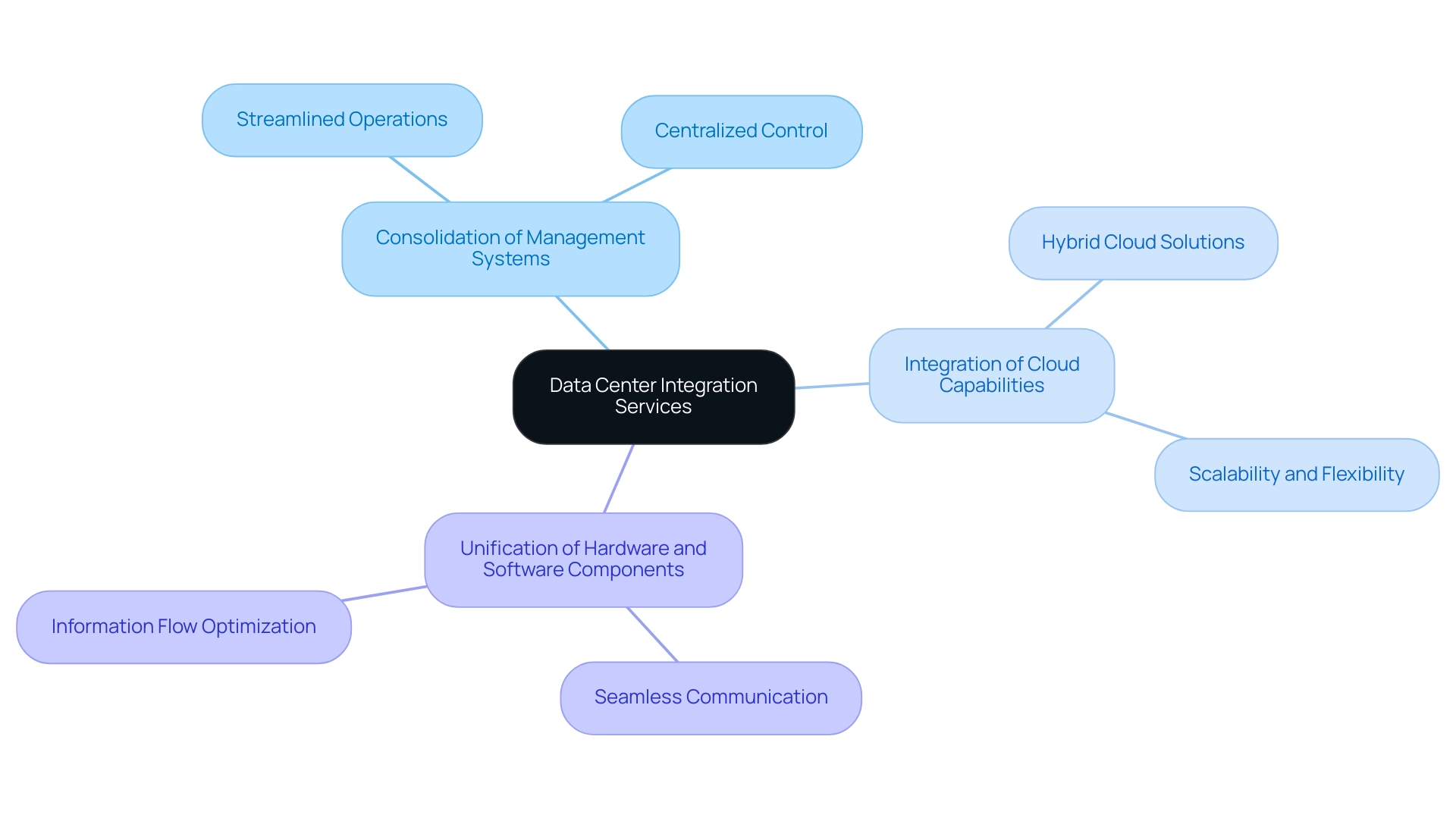
The Importance of Data Center Integration in Modern IT
In today's swiftly changing digital environment, the incorporation of information hubs is crucial for companies aiming to sustain a competitive advantage. As the adoption of hybrid cloud environments and multi-cloud strategies accelerates, the importance of data center integration services becomes increasingly apparent. Mini server facilities, which usually hold 1 to 10 racks and provide computing areas between 1 to 250 square feet, play an essential role in this unification.
Efficient data center integration services not only enhance information accessibility and strengthen operational agility but also provide enterprises with real-time insights for improved decision-making. With information volumes soaring and operational complexities intensifying, strong unification strategies are vital for sustaining efficiency and fulfilling customer expectations. Significantly, the expected expenditure on cloud IT infrastructure is estimated to hit $133.7 billion by 2026, as emphasized by research expert Petroc Taylor, highlighting the necessity for organizations to adjust and enhance their management frameworks.
Moreover, as Latin America sees a slight rise in facility availability, especially in São Paulo, the expansion of hyperscale projects in areas such as Rio de Janeiro demonstrates the regional patterns affecting data center integration services. Additionally, recent case studies on Asia-Pacific leasing availability trends reveal that while leasing availability has slightly risen due to new facilities, demand remains high, emphasizing the critical need for effective data center integration services in a competitive market.
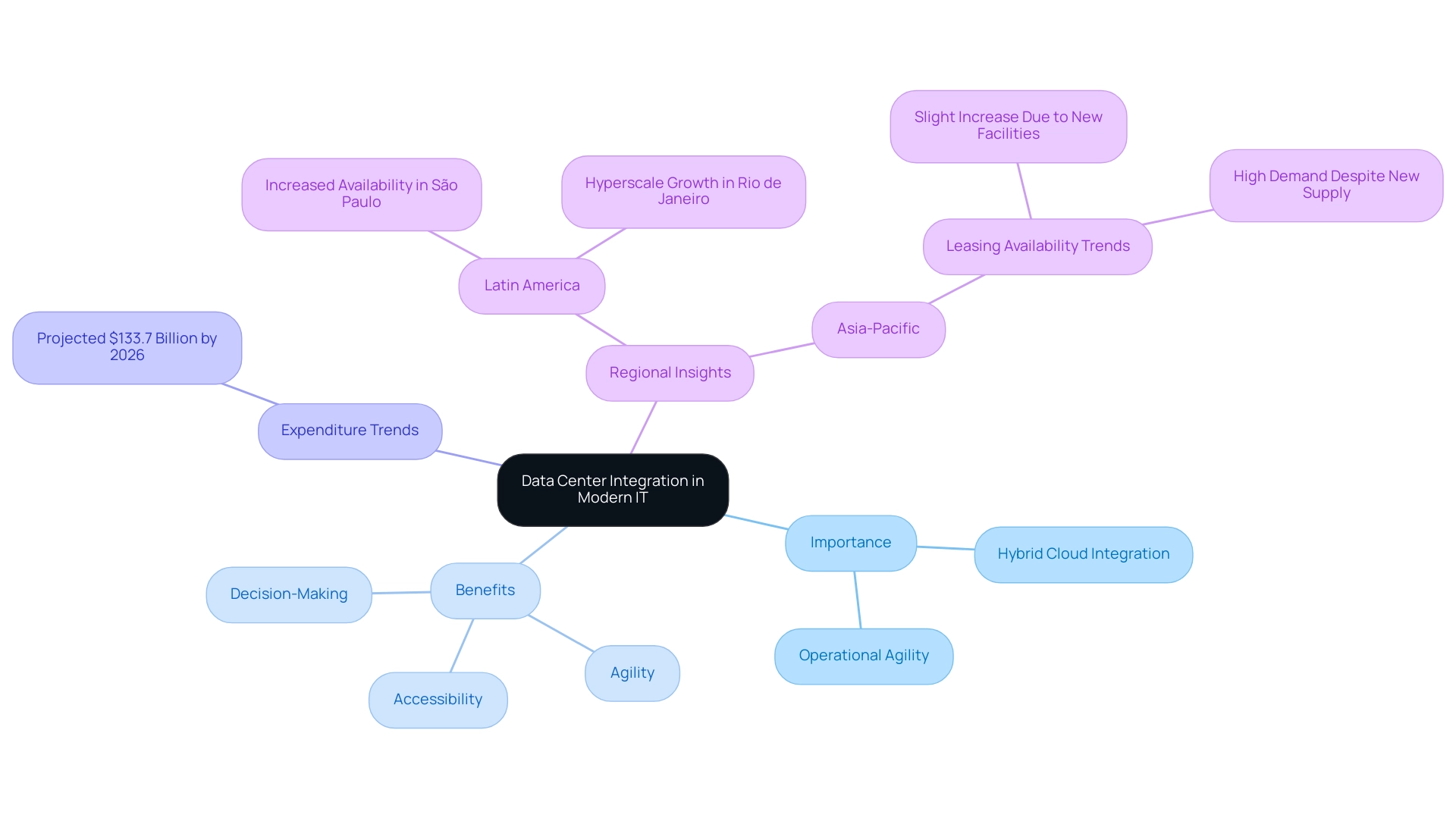
Key Benefits of Data Center Integration Services
Data Center Integration Services provide a multitude of advantages that are essential for entities aiming to optimize their IT infrastructure:
-
Efficiency Improvements: Organizations can significantly reduce operational redundancies by utilizing data center integration services to consolidate disparate systems and automate processes. This streamlining of workflows not only enhances productivity but also aligns with the growing trend towards low-latency computing driven by advancements in 5G, IoT, and the metaverse.
-
Cost Savings: Data center integration services minimize the reliance on multiple isolated systems, resulting in substantial reductions in maintenance costs and lower IT overhead. For instance, companies implementing integrated solutions have reported up to 30% savings in operational expenses. Given that global information transmission networks consumed between 260-360 TWh in 2022, the pressing need for energy efficiency becomes clear, as effective integration can lead to reduced energy consumption and substantial cost savings.
-
Enhanced Performance: Combined storage facilities are crafted to enable quicker information processing and enhance application efficiency with data center integration services. This is essential for user satisfaction and overall business operations, especially in an era where real-time information access is increasingly anticipated. Organizations can effortlessly scale their IT infrastructure in response to evolving business needs by utilizing data center integration services. This flexibility eliminates the complexities often associated with managing multiple systems, allowing for quick adaptations to market demands.
-
Enhanced Security: A cohesive strategy for facility management that incorporates data center integration services improves security protocols and monitoring capabilities. By minimizing vulnerabilities associated with information silos, organizations can better safeguard sensitive materials and strengthen their defenses against possible cyber risks.
As a demonstration of the industry's dedication to sustainability, the Climate Neutral Facility Pact, initiated in January 2021, targets climate-neutral facilities by 2030, with interim goals aimed at enhancing energy efficiency by 20% by 2025. This initiative promotes energy efficiency and sustainable practices. Furthermore, companies such as Microsoft lead by example, having purchased or generated sufficient renewable electricity to match 100% of their operational electricity usage in 2021, mainly within their data facilities.
This commitment not only illustrates the benefits of combined services but also highlights the industry's evolving landscape towards enhanced efficiency and sustainability.
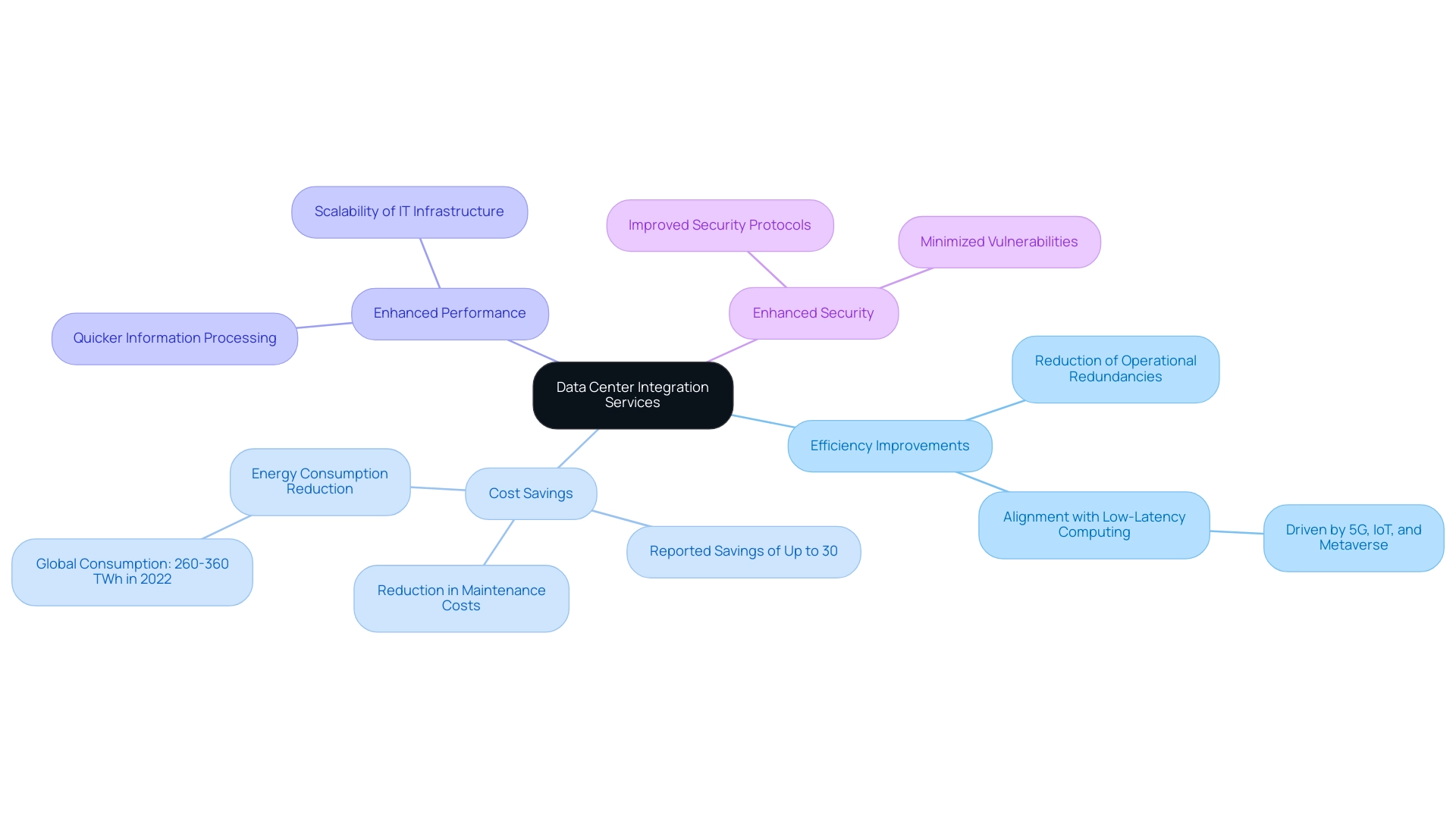
Challenges in Data Center Integration
Data hub consolidation, while providing substantial benefits, presents organizations with numerous challenges that must be managed efficiently for the best results. These challenges include:
-
Complexity of Systems: The combination of legacy systems with contemporary technologies often involves intricate processes that can be both complicated and time-consuming.
This complexity typically demands specialized skills that may not always be readily available within the organization. -
Resistance to Change: A common hurdle in center integration is the resistance from employees towards new processes or technologies.
If change management is not executed effectively, this resistance can lead to disruptions that adversely affect operational continuity. -
Information Migration Issues: Ensuring the integrity of information during migration is paramount.
Any loss or corruption of data can lead to significant repercussions, making it critical for entities to implement robust migration strategies that safeguard data integrity throughout the process. -
Resource Allocation: Successful implementation projects require the allocation of adequate resources, including budget and personnel.
As noted in a recent report, Queretaro is supply constrained, with less than 1.2 MW available for lease as of June 2023, illustrating the real-world challenges in resource availability.
Inadequate management of these resources can burden a company's operations and financial well-being. -
Vendor Compatibility: Achieving seamless interoperability between the solutions provided by various vendors can be challenging.
The Asia-Pacific facility pricing trends suggest that costs have consistently risen due to robust demand and increasing expenses, which can influence assembly costs and supplier choice.
Comprehensive evaluation and extensive testing are vital to guarantee that all elements of the unification function harmoniously.
As the environment of information facilities changes, tackling these challenges will be critical for organizations aiming to utilize the complete potential of their unification efforts.
Significantly, AI is anticipated to propel $75.3 billion in facility expenditure by 2028, underscoring the increasing significance and investment in facility unification.
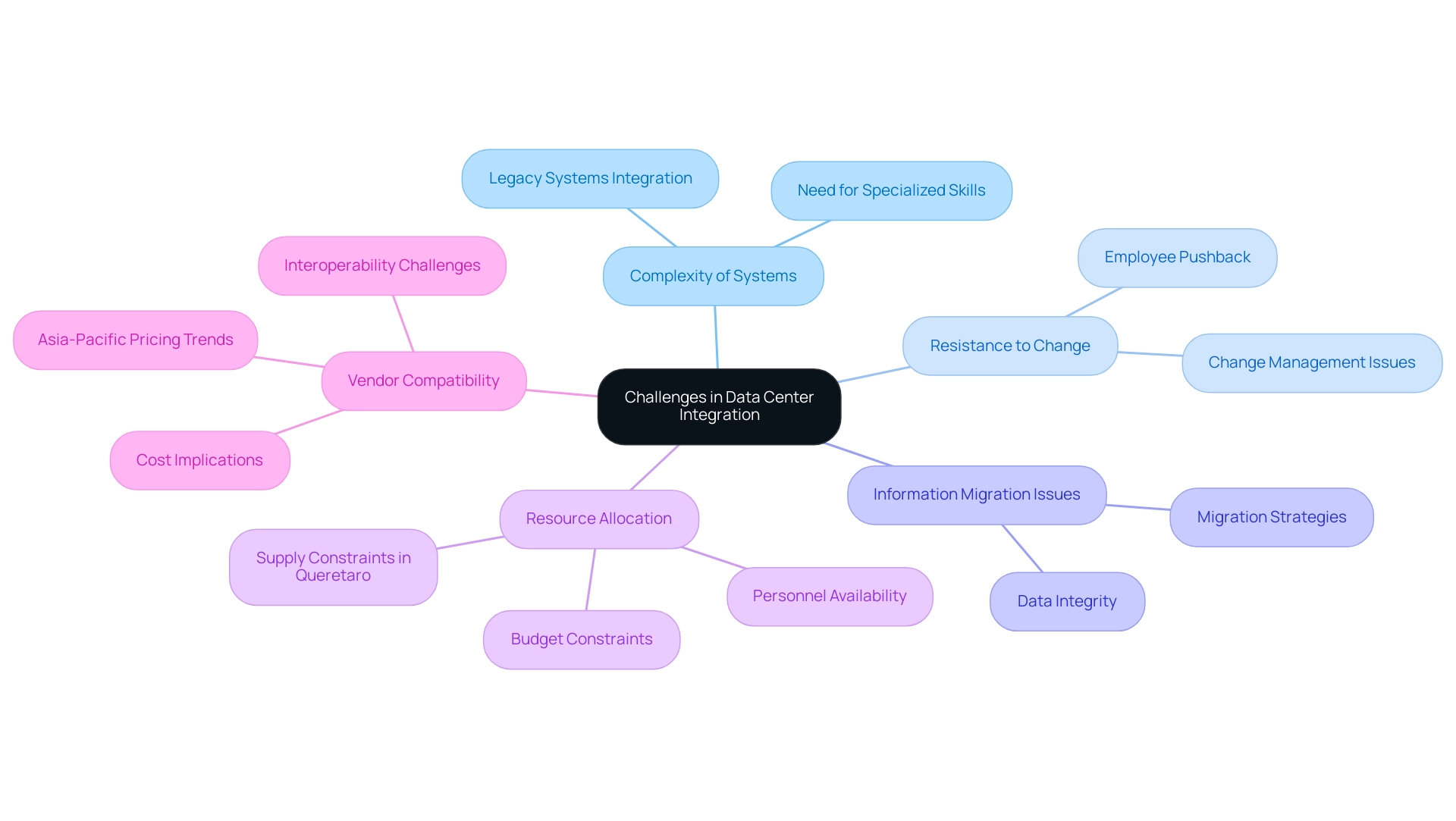
Leveraging Automation for Effective Data Center Integration
Automation is essential to facility unification, significantly improving the efficiency and reliability of operations. By utilizing orchestration software, organizations can automate essential tasks such as:
- Information migration
- System monitoring
- Resource allocation
This not only accelerates integration timelines but also mitigates the risk of human error, fostering a more consistent and reliable operational environment.
With the rise of new technologies and the growing intricacy of workloads—especially with generative AI models expected to boost demand for infrastructure to $76 billion by 2028—automation becomes crucial. Furthermore, regulatory pressures, including the new California law mandating large corporations to disclose carbon emissions by 2026, further emphasize the need for effective facility operations. The case study titled 'Resource Management Optimization through AI' illustrates how service providers are implementing strategies to enhance efficiency and resource management in response to these rising demands.
Automation facilitates real-time updates and enhanced accuracy across integrated systems, ultimately enabling businesses to redirect IT resources toward strategic initiatives. The adoption of automation tools is not just a trend; it signifies a vital evolution in management to satisfy the increasing power, storage, and connectivity requirements of contemporary enterprise environments.
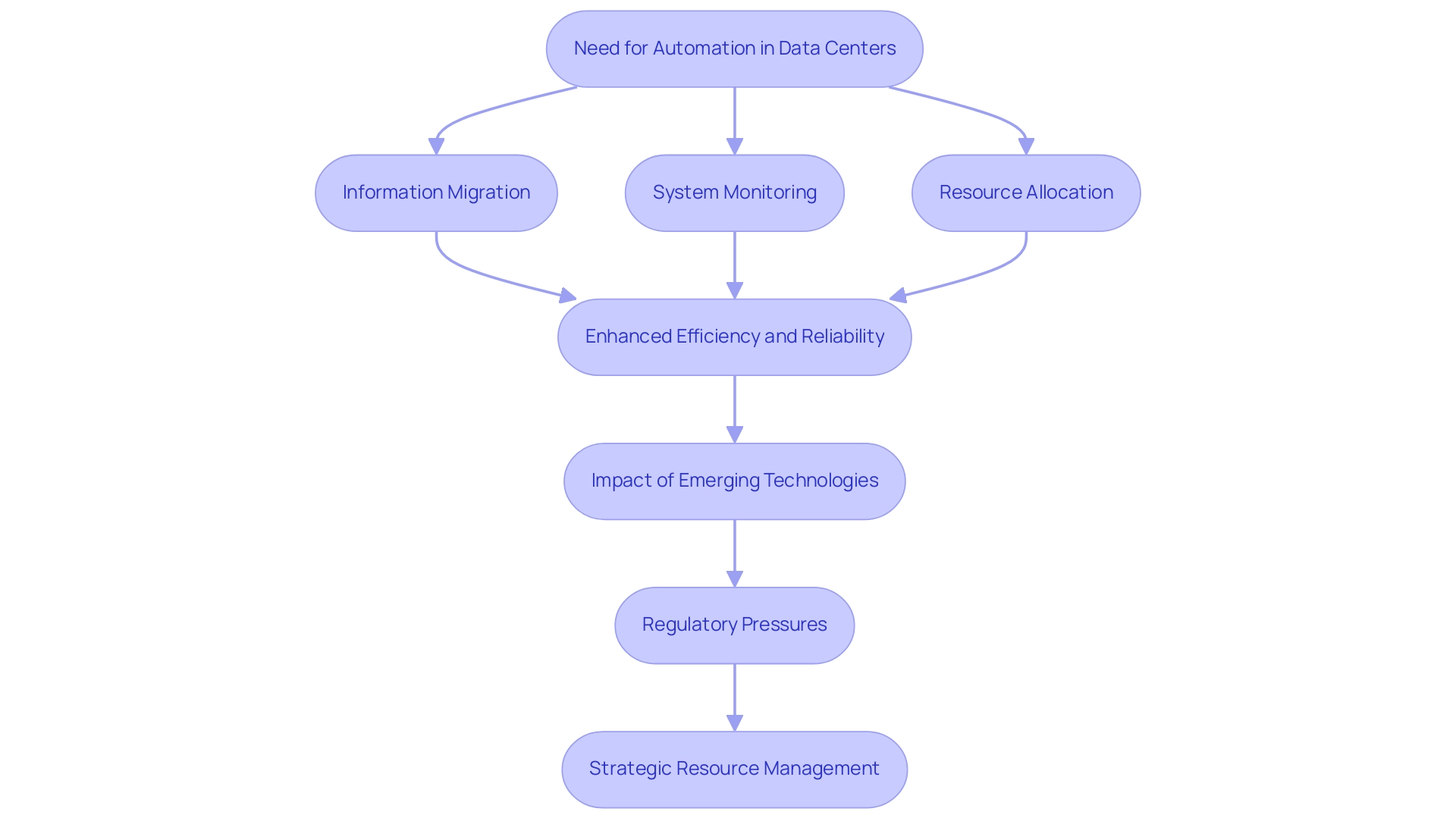
Choosing the Right Data Center Integration Service Provider
Selecting the right data center integration service provider is a critical decision that requires careful consideration of several key factors:
- Experience and Expertise: Prioritize providers with a strong history in resource integration, ensuring they have relevant industry experience that aligns with your organizational requirements. Their proven success in similar environments can significantly influence project outcomes.
- Customization Options: It is essential to confirm that the provider can offer tailored services that cater specifically to your organization’s requirements. A one-size-fits-all approach often leads to suboptimal solutions, so flexibility in service design is paramount.
- Support and Maintenance: Evaluate the level of ongoing support and maintenance that the provider offers post-integration. Ongoing assistance is essential for guaranteeing the durability and efficiency of your infrastructure, reducing possible downtime and operational interruptions.
- Technology Partnerships: Assess the provider’s affiliations with leading technology vendors. Strong partnerships can enhance the quality of the solutions offered, providing access to the latest innovations and best practices in the industry.
- Client References: Request case studies or references from previous clients to better understand the provider’s effectiveness and reliability in executing similar projects. Insights from past clients can provide valuable perspectives on the provider's capabilities and performance.
Considering the growing need for enhanced facility performance, as shown by the anticipated worldwide cloud IT infrastructure expenditures expected to hit 133.7 billion USD by 2026, making a well-informed decision regarding a service provider is more essential than ever. Furthermore, taking into account the statistic that facilities in Finland benefit from over 8,000 hours of free cooling annually emphasizes the significance of location in facility selection. Furthermore, as Jane Smith, CFO, aptly stated, "We expect significant growth next quarter," highlighting the necessity for organizations to invest wisely in their data center integration services.
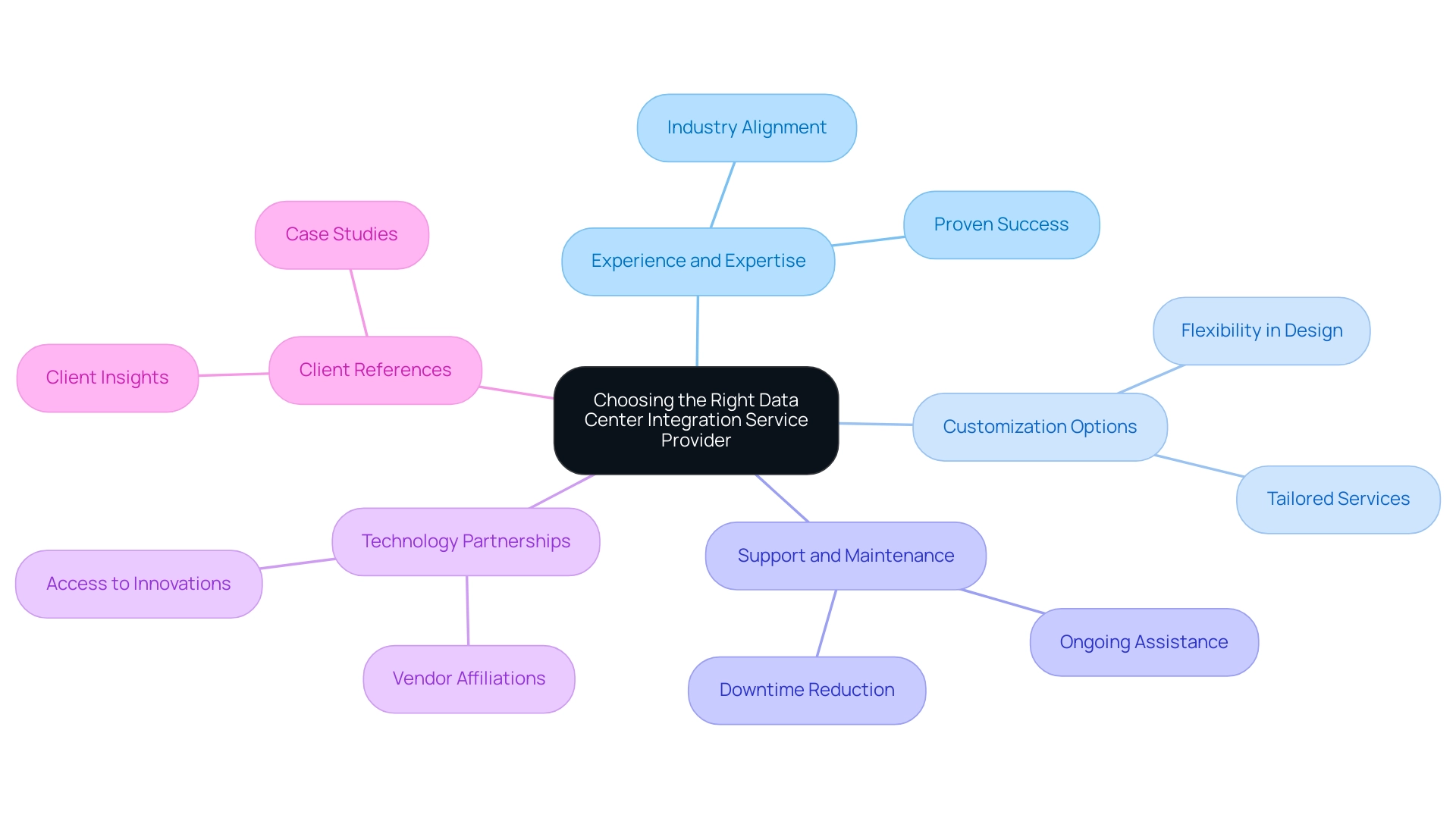
Conclusion
The exploration of Data Center Integration Services reveals their critical role in enhancing organizational efficiency and performance in an increasingly complex technological landscape. These services provide a comprehensive framework for integrating disparate systems, thereby streamlining operations and facilitating seamless data flow. As data volumes surge and the demand for cloud solutions escalates—projected to reach $133.7 billion by 2026—organizations must prioritize effective integration to maintain a competitive edge.
The benefits of data center integration are manifold, encompassing:
- Efficiency improvements
- Cost savings
- Enhanced performance
- Scalability
- Improved security
However, challenges such as:
- System complexity
- Resistance to change
- Data migration issues
must be navigated with strategic foresight. Embracing automation further amplifies the advantages of integration, enabling organizations to optimize operations and respond adeptly to the evolving demands of the digital era.
Ultimately, the choice of a data center integration service provider is paramount. Organizations must seek partners with proven expertise, customizable solutions, and strong support systems to ensure successful integration and ongoing operational excellence. As the landscape of data management continues to evolve, investing in robust data center integration services will be essential for achieving sustainable growth and operational resilience in the face of emerging challenges.




